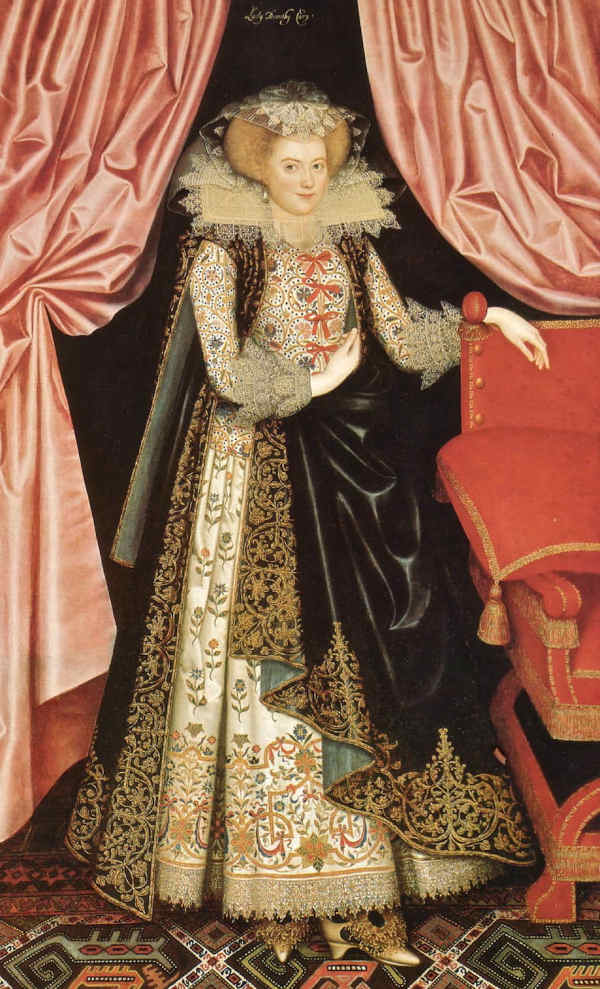"An ape is an ape, a varlet is a varlet, though they be clad in silk or scarlet."
(James Howell, Proverbs or Old Sayed-Sawes and Adages in the English Toung, 1659)
Scarlet in Elizabethan England could describe a type of woolen cloth or the color red, and was commonly favored by women for its warming, healthful properties. Scarlett is also my first name, as in the infamous Miss Scarlett O'Hara. It is fitting, therefore, to begin the blog of my 1590s life with a discussion of red in the late sixteenth century and how I have included it in my Renaissance faire wardrobe.
 |
| Red coral necklace, enamel & pearl earrings, pink possible coral for bracelets |
Red coral harvested from the Mediterranean Sea was very popular for jewelry, particularly for women and children. A quick look through The Tudor Child makes this very apparent. What research I have done has shown their primary usage in necklaces, pairs of matching bracelets, and on clothing. Red coral from the Mediterranean and the related red coral from Japan has been nearly harvested to extinction. However, I was fortunate enough to be given this gorgeous coral necklace for my birthday; it was harvested from the Sea of Japan in the 1970s. The second necklace is possibly coral from Russia, though it is difficult to tell, and was donated to me by my aunt because it is too short to comfortably wear. I plan to restring it into a matching pair of bracelets, like you can see on the three daughters on the right:
 |
| A family saying grace before a meal by Anthonius Claessins, 1585 |
Coral was believed to promote health, especially given its vibrant red color. Its frequent appearance on children and women of childbearing age is indicative of this belief. As a woman in my twenties (and as someone who is frequently sick), it certainly makes sense to wear this beautiful jewelry!
 |
A snapshot from the Original Renaissance Pleasure Faire
Irwindale, 28 April 2013 |
My other favorite scarlet accessory is my tall hat, purchased from Muscovy Trading Company at the Northern California Renaissance Faire several years ago. I have personalized it by adding a coughFEWcough feathers to it, taking it perhaps a smidgen passed my targeted middle class. While it might look a little ridiculous, this ostentatious hat isn't completely fantastical (there is an Italian portrait featuring a woman in a similar hat, but of course now I can't track it down). This hat sums up my costume philosophy rather well as I'm mostly historically accurate (as an historian it's my solemn duty!) but I take a few personal liberties for aesthetics and convenience. This hat also coordinates well with both my red doublet Mach I, barely seen in the above picture, and my proposed red doublet Mach II, as in this sketch:
 |
| Red wool doublet and sleeves that I'm planning |
Red was also frequently worn close to the skin as undergarments. The authors of
The Tudor Tailor did a wonderful job combing through wills and inventories to highlight the obligatory red petticoat (see pages 20-22). Of course, I had to have one of my own!! Mine is made of linen-cotton blend from Joann that I dyed a reddish-orange. I chose the blend because a) it was much thinner than their linen, and b) will mostly only be seen by me, so I don't have to worry as much about accuracy. I went with a simple rectangle cartridge-pleated to a waistband, as it fits with the 1590s look the best. I tried out the period method of seam construction, explained excellently by
Laura Mellin of Extreme Costuming , wherein you finish each piece individually, and then whipstitch them together. It worked wonderfully and looks really neat, I will definitely be sticking with this method.
 |
| My period seam |
I close my petticoat to the side, as I wear a separate pocket underneath all of my skirts (the best thing ever!!!). This was the first time I made eyelets and a fingerloop braid tie, both of which were surprisingly easy and fun to do!
 |
Pretending to reach through to casually put my hand in my pocket.
Cheesy but effective. |
This was one of my best projects to date: handsewn, period construction, fully-finished seams and closures, and fits really nicely. Since I tend to wear separates of doublets and petticoats, I am already considering modifying this underpetticoat a little by adding a canvas bodies to the top half like a kirtle, that way I won't have to do so much work to stiffen my doublets and it is probably more historically accurate. I will certainly blog about it if I make that change before I begin construction of my two planned doublets.
 |
| One last glamour shot!! |
While I may not wear a lot of red in modern (well, vintage) life since yellow is my signature color, I certainly wear a lot of red as an Elizabethan woman. It reminds me of who I am portraying and why I wear the clothing that I do. And besides, I'm Scarlett after all, it's only natural to wear scarlet!!














